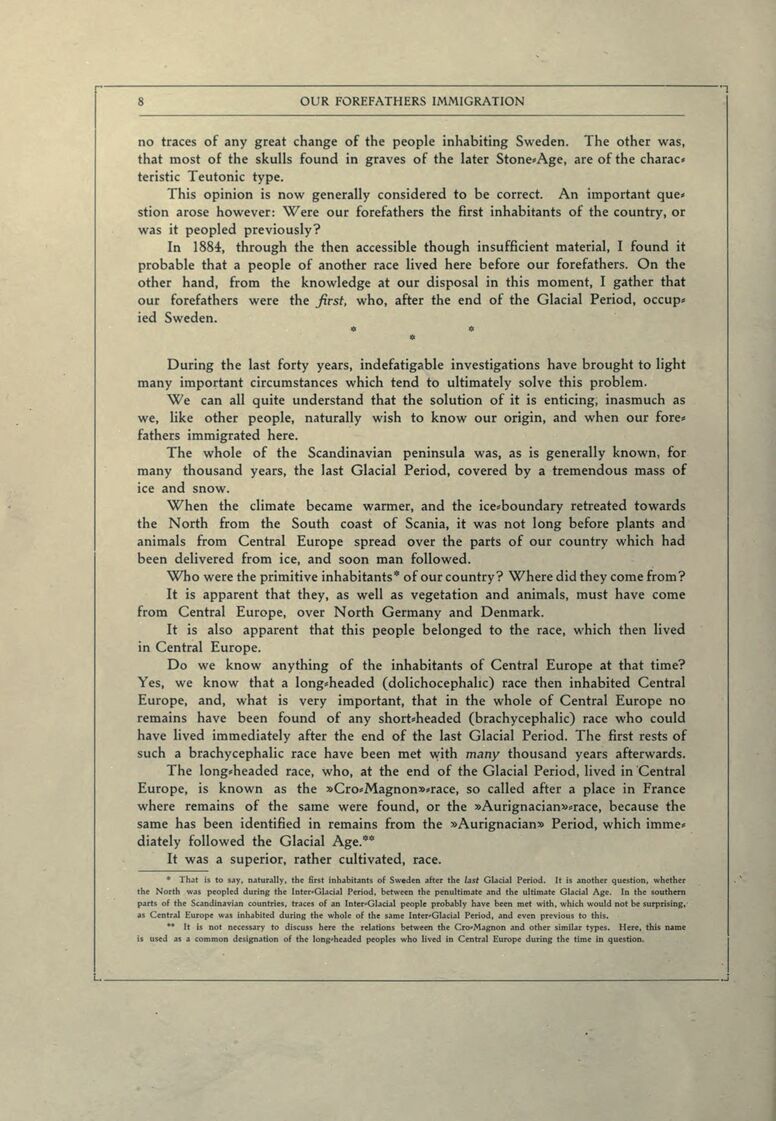
Full resolution (JPEG) - On this page / på denna sida - Part I - Professor Oscar Montelius, Stockholm, The Immigration of our Forefathers to the North

<< prev. page << föreg. sida << >> nästa sida >> next page >>
Below is the raw OCR text
from the above scanned image.
Do you see an error? Proofread the page now!
Här nedan syns maskintolkade texten från faksimilbilden ovan.
Ser du något fel? Korrekturläs sidan nu!
This page has never been proofread. / Denna sida har aldrig korrekturlästs.
no traces of any great change of the people inhabiting Sweden. The other was,
that most of the skulis found in graves of the later Stone*Age, are of the charac*
teristic Teutonic type.
This opinion is now generally considered to be correct. An important que*
stion arose however: Were our forefathers the first inhabitants of the country, or
was it peopled previously?
In 1884, through the then accessible though insufficient material, I found it
probable that a people of another race lived here before our forefathers. On the
other hånd, from the knowledge at our disposal in this moment, I gather that
our forefathers were the first, who, after the end of the Glacial Period, occup»
ied Sweden.
tf tf
tf
During the last forty years, indefatigable investigations have brought to light
many important circumstances which tend to ultimately solve this problem.
We can all quite understand that the solution of it is enticing, inasmuch as
we, like other people, naturally wish to know our origin, and when our fore»
fathers immigrated here.
The whole of the Scandinavian peninsula was, as is generally known, for
many thousand years, the last Glacial Period, covered by a tremendous mass of
ice and snow.
When the climate became warmer, and the ice*boundary retreated towards
the North from the South coast of Scania, it was not long before plants and
animals from Central Europe spread over the parts of our country which had
been delivered from ice, and soon man followed.
Who were the primitive inhabitants* of our country? Where did they come from?
It is apparent that they, as well as vegetation and animals, must have come
from Central Europe, over North Germany and Denmark.
It is also apparent that this people belonged to the race, which then lived
in Central Europe.
Do we know anything of the inhabitants of Central Europe at that time?
Yes, we know that a long»headed (dolichocephalic) race then inhabited Central
Europe, and, what is very important, that in the whole of Central Europe no
remains have been found of any short*headed (brachycephalic) race who could
have lived immediately after the end of the last Glacial Period. The first rests of
such a brachycephalic race have been met with many thousand years afterwards.
The long»headed race, who, at the end of the Glacial Period, lived in Central
Europe, is known as the »Cro*Magnon»*race, so called after a place in France
where remains of the same were found, or the »Aurignacian»*race, because the
same has been identified in remains from the »Aurignacian» Period, which imme«
diately followed the Glacial Age.**
It was a superior, rather cultivated, race.
* That is to say, naturally, the first inhabitants of Sweden after the hst Glacial Period. It is another question, whether
the North was peopled during the Inter*Glacial Period, between the penultimate and the ultimate Glacial Age. In the Southern
parts of the Scandinavian countries, traces of an Inter«Glacial people probably have been met with, which would not be surprising,
as Central Europe was inhabited during the whole of the same Inter’Glacial Period, and even previous to this.
•• It is not necessary to discuss here the relations between the Cro’Magnon and other similar types. Here, this name
is used as a common designation of the long’headed peoples who lived in Central Europe during the time in question.
L.
<< prev. page << föreg. sida << >> nästa sida >> next page >>